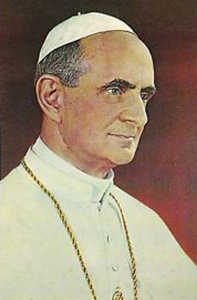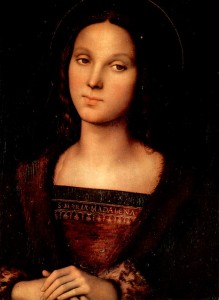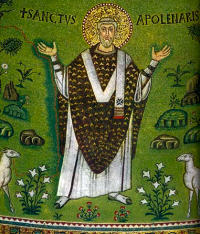PAUL VI (Giovanni Battista Montini), Pope

Feast Day: September 26
Canonized: October 14, 2018
Beatified: October 19, 2014
Venerated: December 20, 2012
As a child, Giovanni Battista Montini was often ill. He could not do many of the things that other children his age could do, but he loved to study and read. After he finished high school, he studied for the priesthood and was ordained in 1920.
Father Montini went on to hold a variety of important positions in the Church. In 1953, he was named archbishop of Milan. There he fought for the rights of workers and worked to improve relationships among all the Christian traditions. In 1958, he was named a cardinal of the Catholic Church.
When Pope John XXIII died in 1963, Archbishop Montini was elected pope. He took the name Pope Paul VI. Pope Paul VI promised to continue the work begun by Pope John XXIII. He saw to it that the decisions of Vatican II were carried out. He traveled to five continents, making him the first pope in 150 years to leave Italy.
Pope Paul VI also continued to work to improve relationships with other Christian traditions. In 1964, he traveled to the Holy Land and met with Patriarch Athenagoras I of Constantinople, in an effort to mend relations with the Eastern Orthodox Church. Later that year, he traveled to India, and in 1965 he traveled to the United States and addressed the United Nations.
In 1968, Pope Paul VI wrote an encyclical titled Humanae Vitae (Of Human Life). In this document, Pope Paul VI instructed Catholics on the importance of welcoming children into their families and on respecting human life.
Pope Paul VI died on August 6, 1978. On October 14, 2018, Pope Francis named him a saint of the Church.
Continuing the Conversation . . .
Primary Grades: As a child, Pope Paul VI could not do many of the things other children his age could do. But he loved to study and read.
Invite the children to name books they love to read and subjects they love to study. Then invite them to draw pictures of themselves doing something they wish they could do. Ask volunteers to share their drawings with the class.
Intermediate Grades: Throughout his life, Pope Paul VI held many important positions in the Church.
Invite the young people to name persons they see serving your parish community and the ways those persons are doing so. Ask the young people how they themselves are serving the Church now, and how they see themselves serving the Church in five, ten, or twenty years.
Junior High: Pope Paul VI’s encyclical Humanae Vitae (Of Human Life) focused on respect for human life.
Draw a large timeline on a length of mural paper or shelf paper. Mark the timeline in five-year increments, from 0 to 80 or from 0 to 100. Post the timeline, and invite the young people to write in the appropriate time segments practical ways to respect human life. For example, in the 0-5 year segment young people might write: “Provide healthy food for infants” or “Begin to teach young children to read.” In the 75-80 year segment young people might write: “Provide transportation for an elderly relative or neighbor” or “Shovel the walks of an elderly neighbor.”
If possible, leave up the timeline so the young people can continue to add to it throughout the coming week.
Related Resources
Connecting to Blest Are We Faith in Action
The Story of Jesus
Feasts and Seasons (Flourish)
Connecting to Blest Are We Faith in Word
The Story of Jesus
Feasts and Seasons: Holy People
Connection to Be My Disciples
Christ in the Liturgy, Chapter 1




Comments are closed.